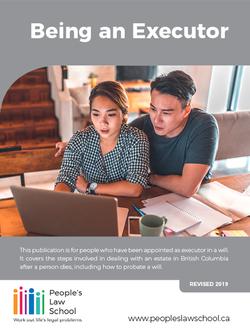Being an Executor: Difference between revisions
No edit summary |
No edit summary |
||
| Line 13: | Line 13: | ||
* '''[[Ten Steps to Being an Executor]]''' | * '''[[Ten Steps to Being an Executor]]''' | ||
** [[Ten Steps to Being an Executor#Step 1. | ** [[Ten Steps to Being an Executor#Step 1. Find the will|Step 1. Find the will]]{{·}}[[Ten Steps to Being an Executor#Step 2. Confirm the validity of the will|Step 2. Confirm the validity of the will]]{{·}}[[Ten Steps to Being an Executor#Step 3. Protect the assets|Step 3. Protect the assets]]{{·}}[[Ten Steps to Being an Executor#Step 4. Arrange the funeral|Step 4. Arrange the funeral]]{{·}}[[Ten Steps to Being an Executor#Step 5. Communicate with the beneficiaries|Step 5. Communicate with the beneficiaries]]{{·}}[[Ten Steps to Being an Executor#Step 6. List the assets and liabilities|Step 6. List the assets and liabilities]]{{·}}[[Ten Steps to Being an Executor#Step 7. If necessary, apply for probate|Step 7. If necessary, apply for probate]]{{·}}[[Ten Steps to Being an Executor#Step 8. Deal with debts and taxes|Step 8. Deal with debts and taxes]]{{·}}[[Ten Steps to Being an Executor#Step 9. Account to the beneficiaries|Step 9. Account to the beneficiarie]]{{·}}[[Ten Steps to Being an Executor#Step 10. Distribute the estate|Step 10. Distribute the estate]] | ||
* '''[[Probating the Will]]''' | * '''[[Probating the Will]]''' | ||
Revision as of 04:43, 21 March 2019

|
|
This is a Clicklaw Wikibook, a collaborative, plain language legal publication that is updated as a wiki and can be printed or downloaded. |
|
|
Download the full Wikibook in PDF. |
|
|
Customize: take what you need, leave the rest (learn more). |
Being an Executor from People's Law School is for people who have been appointed as executor in a will. It covers the steps involved in dealing with an estate in British Columbia after a person dies, including how to probate a will. The information reflects the Wills, Estates and Succession Act, which became law in 2014.
Contents
- Being Asked to Be an Executor
- An executor carries out the instructions in a will · Being an executor can be a demanding job · You don’t have to act as executor · If you decide to act as executor, you can get help · There are some expenses and fees you can claim · There can be more than one executor · An executor’s role ends when the court formally discharges them · If you agree to being someone’s executor
- Ten Steps to Being an Executor
- Step 1. Find the will · Step 2. Confirm the validity of the will · Step 3. Protect the assets · Step 4. Arrange the funeral · Step 5. Communicate with the beneficiaries · Step 6. List the assets and liabilities · Step 7. If necessary, apply for probate · Step 8. Deal with debts and taxes · Step 9. Account to the beneficiarie · Step 10. Distribute the estate
- Resources
Copyright & Disclaimer
![]() Being an Executor © People’s Law School is, except for the images, licensed under a Creative Commons Attribution-NonCommercial-ShareAlike 2.5 Canada Licence.
Being an Executor © People’s Law School is, except for the images, licensed under a Creative Commons Attribution-NonCommercial-ShareAlike 2.5 Canada Licence.
At People's Law School, we believe accurate, plain English information can help people take action to work out their legal problems. This resource explains in a general way the law that applies in British Columbia. It is not intended as legal advice. For help with a specific legal problem, contact a legal professional. Some sources of legal help are highlighted in the "Where to Get Help" section.
People's Law School

People's Law School is a non-profit society in British Columbia providing free education and information on the legal problems of daily life.